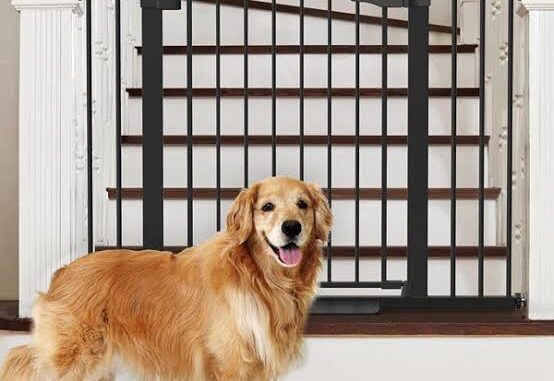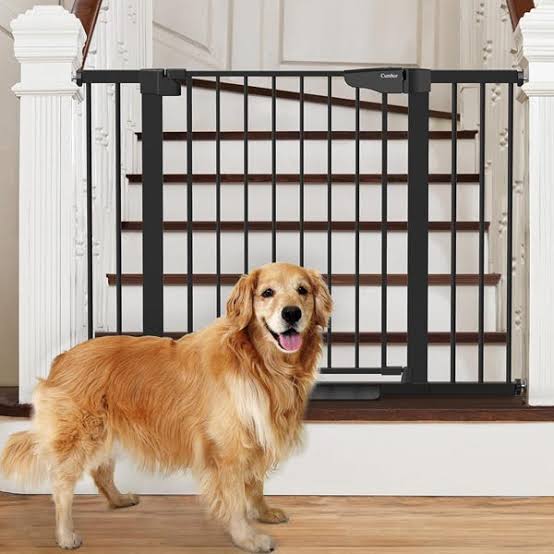
How to Choose the Best Pet Gate for Safety: For many pet owners, ensuring the safety of their pets while maintaining order within the home is a top priority. Whether you’re trying to restrict your dog from the kitchen, keep a curious cat out of the nursery, or protect an energetic puppy from dangerous stairs, a pet gate can be an invaluable tool.

But not all gates are created equal. With so many styles, materials, and features available, it can be challenging to find the perfect one for your home and your pet’s unique needs.
This detailed guide walks you through everything you need to know about choosing the best pet gate for safety—from key considerations and gate types to installation tips and expert recommendations.
Why Use a Pet Gate?
Pet gates aren’t just about setting boundaries—they’re essential safety tools. Here are some common reasons to install a pet gate:
- Prevent access to dangerous areas (like stairs, garages, kitchens, or workshops)
- Protect your belongings from curious or destructive behavior
- Create designated spaces during training or recovery from surgery
- Separate pets from young children or other animals during introductions
- Establish quiet zones for pets to relax
Regardless of your reason, the right pet gate will provide peace of mind while keeping your furry friends secure and comfortable.
Key Considerations When Choosing a Pet Gate
Before selecting a pet gate, you’ll want to assess your home environment, your pet’s behavior, and specific safety needs. Here are the most critical factors:
1. Pet Size and Strength
- Small dogs, cats, and puppies can be contained with shorter or lighter gates.
- Large dogs or strong breeds (like Huskies or German Shepherds) may need tall, reinforced gates made of metal or hardwood.
- Jumpers and climbers may require extra-height gates or designs without footholds.
2. Purpose and Placement
Where and why you’re using the gate matters:
- Stairways: Require hardware-mounted gates to prevent falls.
- Doorways or hallways: Pressure-mounted gates may suffice.
- Open floor plans: Freestanding or expandable gates can divide larger areas.
- Outdoor spaces: Weatherproof gates are necessary for decks or porches.
3. Mounting Style
There are three main types of pet gate installation:
a. Pressure-Mounted Gates
- Held in place by tension
- No drilling or tools required
- Ideal for temporary use and flat surfaces
- Not recommended for top of stairs
b. Hardware-Mounted Gates
- Screwed into the wall or door frame
- Permanent and highly secure
- Best for high-risk areas like stairs
- Requires installation
c. Freestanding Gates
- Portable and self-supporting
- No installation required
- Best for non-aggressive pets and light use
- Can be knocked over by large pets
4. Material
Gates come in a variety of materials, each with its pros and cons:
| Material | Pros | Cons |
|---|---|---|
| Metal | Strong, durable, pet-chew proof | Heavier, may scratch floors or walls |
| Wood | Stylish, warm, blends with décor | Can be chewed or scratched |
| Plastic | Lightweight, affordable | Less durable, not ideal for big dogs |
| Mesh/Fabric | Soft and portable | Low security, not good for chewers |
5. Height and Width
- Standard pet gates range from 24″ to 36″ tall.
- Extra-tall gates (up to 41″+) are ideal for large or jumpy pets.
- Make sure the gate spans the full width of the doorway or area—many gates include extension panels to accommodate wider spaces.
6. Ease of Use
- Look for one-handed operation for busy pet parents.
- A walk-through door or swinging panel allows human access.
- Auto-close or stay-open features add convenience in high-traffic areas.
7. Safety Features
- Latch security: Prevents pets from opening gates themselves.
- Vertical bars or mesh: Discourage climbing.
- No bottom bar at the top of stairs: Prevents tripping hazards.
8. Aesthetics and Home Design
Your pet gate doesn’t have to be an eyesore. Many brands offer stylish options in:
- Wood finishes (oak, cherry, espresso)
- Decorative metal scrollwork
- Neutral or color-matching plastics
Types of Pet Gates
1. Standard Swing Gates
These are traditional gates that open like a door and may be hardware- or pressure-mounted. They’re sturdy, reliable, and often used at staircases or hallways.
Best for: High-traffic areas, daily use
2. Accordion or Expandable Gates
These gates can be widened or narrowed to fit different spaces. Some designs stretch out and lock in place.
Best for: Flexible placement in irregular spaces
3. Freestanding Gates
These sit on the floor and don’t require installation. Many models can fold or expand and are easy to move.
Best for: Portable use, renters, elderly pets
4. Step-Over Gates
Low gates meant to be stepped over rather than opened. Suitable for small pets and temporary blocking.
Best for: Small dogs, puppies, or training areas
5. Retractable Gates
Made from mesh or fabric, these roll into a wall-mounted casing. They’re discreet and space-saving.
Best for: Tight spaces, modern aesthetics
6. Outdoor Pet Gates
Weather-resistant and rust-proof gates made from treated wood or metal. Useful for decks or garden access.
Best for: Outdoor containment or patio safety
Installation Tips
- Always measure your space before buying a gate.
- Use a level to ensure even mounting.
- For pressure-mounted gates, make sure the surface is strong (not drywall only).
- Avoid placing freestanding gates near items pets can use to jump.
- Install hardware-mounted gates into wall studs for maximum security.
READ ALSO: Best Pet Apps for Tracking Health and Vet Visits in 2025
Maintenance and Durability
- Clean gates regularly, especially plastic or mesh ones, to avoid pet hair buildup.
- Inspect hinges and latches periodically.
- Replace worn parts (springs, fasteners, etc.) to maintain safety.
- If your pet chews wood or plastic, opt for metal models.
Recommended Pet Gate Brands
- Carlson Pet Products – Great for chew-proof metal gates, often includes small pet doors.
- Regalo – Budget-friendly, ideal for wide spaces and staircases.
- Richell – Offers stylish wooden gates that suit modern homes.
- North States – Known for sturdy hardware-mounted gates.
- Evenflo – Offers versatile baby/pet combo gates.
FAQs
What’s the difference between a pet gate and a baby gate?
While they serve similar purposes, pet gates are often taller, stronger, and designed to withstand chewing and jumping. Baby gates prioritize child-safe latches and often have a different height or spacing in bars.
Can I use a pressure-mounted gate at the top of stairs?
No. Only hardware-mounted gates should be used at the top of stairs to prevent accidental dislodging and falls.
What’s the best gate for large dogs?
Look for extra-tall (at least 36–41”) metal gates that are hardware-mounted. Gates with vertical bars and strong latches are best for powerful dogs.
Will a pet gate damage my walls or doorframes?
Pressure-mounted gates may leave scuff marks if overtightened. Hardware-mounted gates require drilling but offer greater safety. Use protective wall cups or mounting kits to minimize damage.
Are there gates that let cats through but block dogs?
Yes! Some gates feature small pet doors at the bottom that allow cats or smaller pets to pass while keeping larger dogs contained.
Can I move a pet gate from room to room?
Freestanding and pressure-mounted gates are highly portable. Hardware-mounted gates are fixed but some models allow for quick removal from wall brackets.
What gate works best for a climbing or jumping pet?
Use extra-tall gates with vertical bars (no horizontal footholds). Avoid mesh or accordion-style gates that encourage climbing.
Can I use a gate outdoors?
Only if the gate is specifically rated for outdoor use—usually powder-coated metal or weather-treated wood. Indoor gates may rust or warp if used outside.
How do I train my pet to respect the gate?
Introduce the gate positively:
- Use treats to reinforce boundaries
- Don’t let pets push or jump on the gate
- Monitor their behavior and correct gently
Most pets learn quickly once they realize they can’t get through.
Leave a Reply
You must be logged in to post a comment.